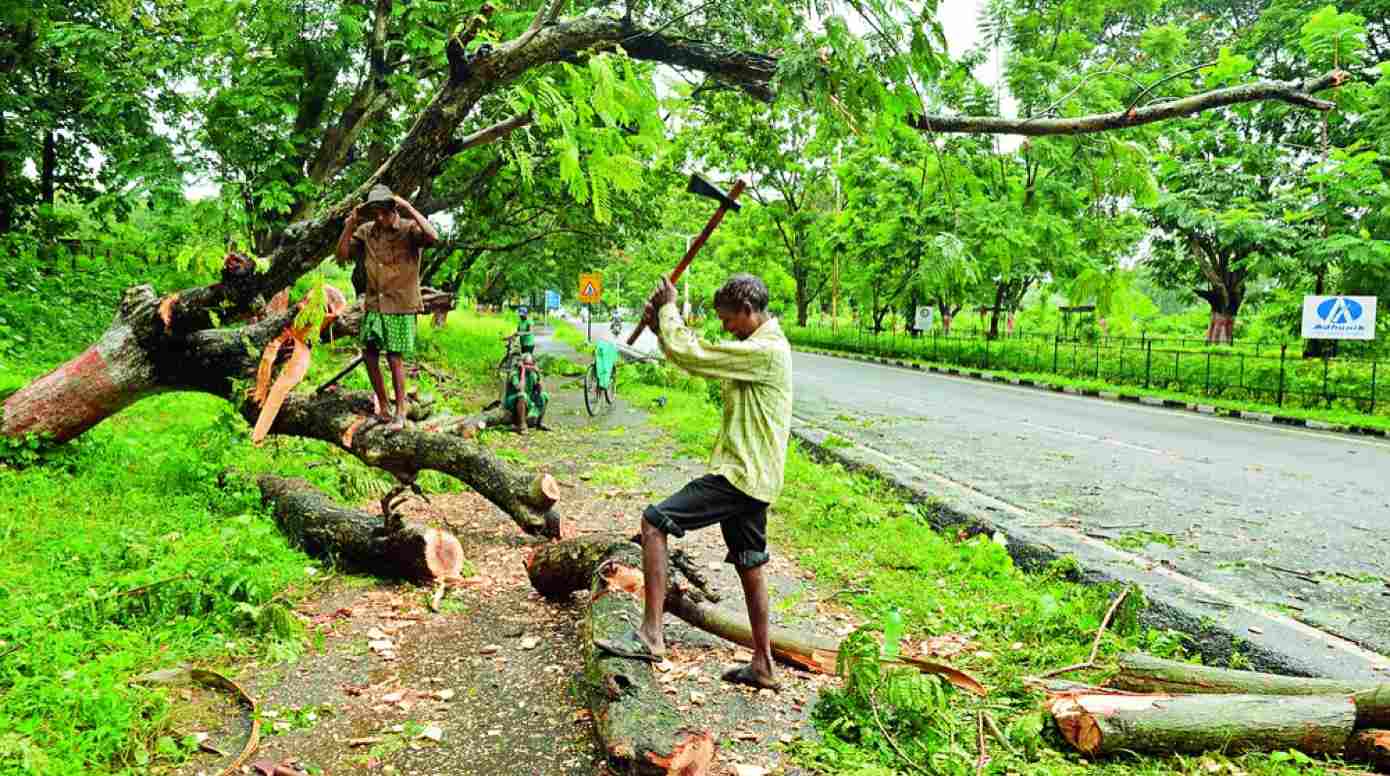Questioning Forest Act- How Do Government And Companies Like ITC Get Away With Cutting Thousands Of Trees?
Why is a tribal person cutting a tree a criminal under Indian Forest Act, whereas government or huge corporates cutting thousands of trees not liable?

Questioning Forest Act
The Indian Forest Act (IFA) reinforces the colonial idea that the government has a monopolistic ownership of forests as well as its resources, while arguing that anybody else constitutes an intruder possessing no rights. In accordance with autonomous India’s Constitutional tenets, current legislative changes, and court pronouncements, it is wise to propose that the IFA’s stance should be reconsidered to designate the government to be a custodian of forests as opposed to an owner of them.
Both of the initial two National Forest Policies were based upon an exploitative comprehension of forests. The third version of the National Forest Policy, issued in 1988, had an increasingly protectionist stance. The IFA should be updated to reflect such a protective attitude regarding forests. To that purpose, ‘deemed forests’ ought to be incorporated in its scope.
IFA’s present classification of wildlife as a ‘forest-produce’ excludes it from its purview. This is especially troubling considering that thirty-five percent of tiger range as well as 36 animal species are situated in forests which are not currently designated as protected areas. As a result, it is critical for IFA to employ a comprehensive strategy and recognize that forests serve as habitat and transportation corridors for animals.
Changes to the penalty amount: The maximum fine stipulated by the IFA is now INR 500, which has been constant from the Act’s inception in 1927. This sum is insufficient to deter criminals or repair environmental harm in our current time.
The Act’s whole criminal provisions needs to be updated to account for inflation as well as bring it into accordance with other environmental laws. According to the latest suggested modification to the India Forest Act (IFA), 1927 from the nation’s environment ministry, a fine of INR 500 would take the place of a six-month jail sentence for trespassing, collecting timber, and illegally felling trees of the forest. This is a component of the effort to decriminalize various environmental offenses.

The government is reviewing the Forest Act to see whether any portions need to be amended. The goal of the process is to decriminalize relatively minor legal infractions, hasten settlement through the piling of lesser offenses, lessen the burden on individuals to comply with the law, rationalize punishments, and minimize harassing of citizens.
The Forest Act establishes the regulatory structure for the management and conservation of forests, as well as for the transportation of forest products and wood and the imposition of taxes on such products. The IFA is a general Act that stipulates the fundamental framework for the administration of forests in the nation, including a method to assure reporting of reserved, protected, as well as village forests, safeguarding of forest resources, and preservation of the nation’s forest ecosystems and species.
This is happening at a time when the Union’s Ministry of the Environment is attempting to legalize transgressions of a number of green regulations. The ministry has additionally proposed amendments to the Environment (Protection) Act, 1986, Water (Prevention and Control of Pollution) Act, 1974, Air (Prevention and Control of Pollution) Act, 1981, as well as the Public Liability Insurance (PLI), Act 1991, deeming it to be an attempt to eliminate the dreaded prospect of jail time for minor infractions.
At times there are difficulties in differentiating between a major and minor offense and because of that punishment is often not distinct. This abuts habitual offenders to commit more crimes as there is the same level of punishment for both first-time and repeat offenders. Hence there is a need to incorporate differential Penal provisions in the Act by amending it.
– Government environment ministry
A close examination of the Indian Forest Act of 1927 demonstrates that while it may have appeared that the novel provisions, rules, and regulations it introduced were meant to safeguard and preserve India’s forest cover, their true purpose was to generate income from the harvest of the forest’s vegetation, wood, timber, fodder, rocks, as well as minerals.
This law granted the bureaucrats along with the forest authorities a great deal of power, which frequently results in the mistreatment of the forest people. Additionally, it denied the entitlements and advantages of the nomadic tribes, indigenous peoples, and forest dwellers to utilize the forest products.
This law was never intended to control tree-cutting, but rather to increase money from it in a way that preserves forestland. Uncertainty over criminal culpability with lighter penalties vs decriminalization- The modifications do not make the offenses less serious. Even if there is no longer jail as a sanction, they remain crimes. It must be made clear whether the goal is to fully decriminalize the offense or to keep criminal culpability.
The prescribed fine sum of INR 500 is too small to serve as a deterrence. The fine amount has grown in some states that have altered these particular regulations over time. To discourage criminals, repair environmental harm, and motivate state governments to alter their laws and impose larger penalties, it is crucial that the Center establish a severe penalty sum in the legislation. The punishment must take into consideration the harm done.

Two of the offenses for which the removal of imprisonment has been suggested are-
- inflicting any harm through negligence when falling any tree or cutting or hauling any timber in designated forests, as well as
- resulting in damage to a designated tree when felling any tree or timber. The imposed punishment need to take into consideration the harm done to the forest along with the resources present.
Deforestation on an extensive basis has historically been a problem for the natural world, however in the past few years, due to climate change, it has gained enormous international attention. Large volumes of carbon dioxide released during different economic activity are absorbed by forests, preventing global warming. At the Glasgow climate conference in 2021, a little over 100 nations committed to halting deforestation by 2030 while also beginning its reversal.
In an effort to project an image of environmental responsibility, many nations and businesses now make an effort to guarantee that they don’t consume any goods that may be the consequence of illicit logging or deforestation. Additionally, legislation governing the entrance and sale of goods made from wood in Europe and the US have been passed.
In order to validate the origin, legitimacy, and sustainability of items made from forests, such as wood, furniture, handicrafts, paper and pulp, rubber, among many others, the certification processes steps in. It does this by providing a multi-layer audit system.
A multi-layer audit system is provided by the certification provider in an effort to independently verify the source, lawfulness, and sustainability of goods made from trees, such as wood, furniture, handicrafts, paper along with pulp, rubber, etc. FSC and PEFC are the two main standards. Although they both function in India, the government is also developing its own national requirements.
The national criteria set by the Indian government, however, are so dubious. The case of the Indian Tobacco Company serves as an illustration for this. With barely INR 38 crore in paid-up capital, Indian Tobacco Company (ITC), formerly referred to as American Tobacco Company (ATC), commenced its operations in India around 1940. Only the name of this ITC corporation was altered, yet it is still owned by America.
In the financial year 2022, ITC Limited recorded revenues of almost 623 billion Indian rupees. ITC was founded in 1910 as a tobacco firm and maintained just that for over 60 years before branching out into printing as well as packaging for the production of cigarettes. ITC has an overall market percentage of seventy-seven percent for cigarettes and offers a broad variety of brands. This industry generated around 46% of the conglomerate’s overall income.

According to a 2011 figure, this corporation currently destroys 1 tree with every 500 cigarettes it produces resulting in approximately 14 crores trees annually. After then, there is no information available to even estimate the number of trees that are cut down year to support ITC’s cigarette industry. Every year, thousands of individuals pass away from cancer brought on by these cigarettes. How could a pitiful sum of INR 500 make a difference for such a company?
In addition, ITC recently published its extensive report, which is stretched across 140 pages and provides a full explanation of its goal, measures, and accomplishments, to provide perspective on ITC’s sustainable features. The report highlights the efforts ITC has undertaken to reduce carbon emissions, develop green infrastructure, support climate-smart as well as regenerative agriculture, guarantee universal access to clean water, restore biodiversity by means of solutions based on the natural world, establish an efficient circular economy, develop environmentally friendly packaging options, and facilitate the shift to a net zero economy.
Can’t we all predict how accurate and successful these measures will be? Knowing the company’s scope of operations, it is clear how much influence it has over both the Indian government and the relevant agencies. A poor ordinary man in India cannot chop a tree to prepare his supper, but this ITC firm can destroy 14 crore trees each year, if not more, merely to create cigarettes and cause cancer throughout India.
This negligent government enables this American company to remove 14 crore trees every year while shouting “Green India” slogans and telling its citizens that we are facing a global warming issue and that they should plant trees. The issue is that even if tribals only cut one tree, they are criminals. However, if a large corporation destroys thousands of trees, it is hailed as growth and development.
We must all ask ourselves and the government, “What exactly is going on?”




